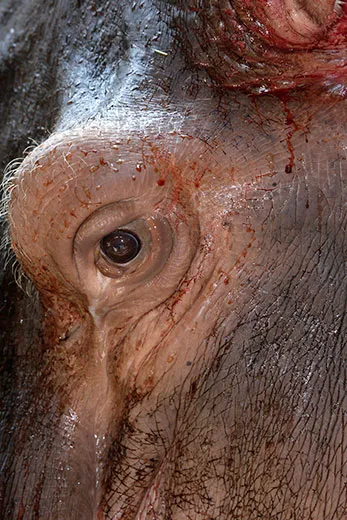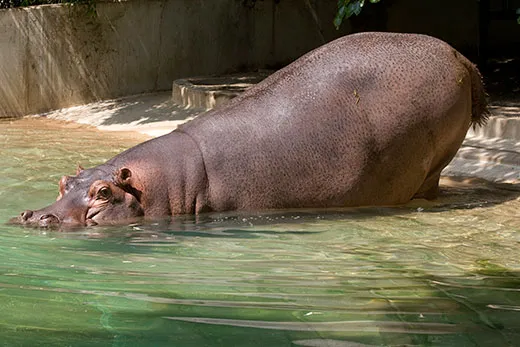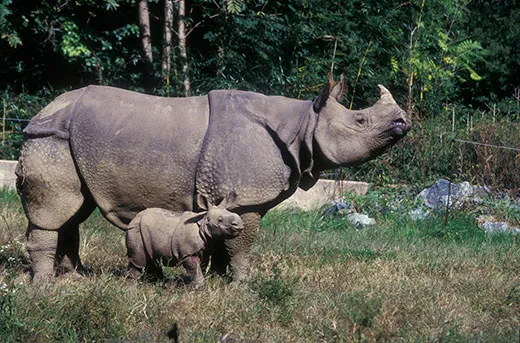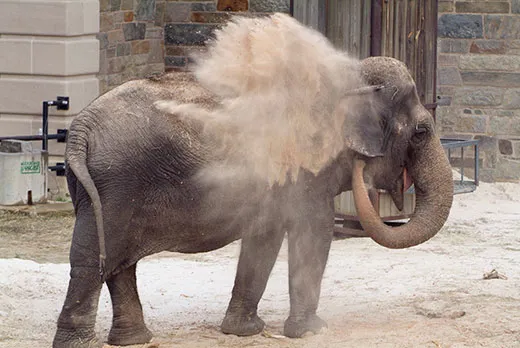Ask an Expert: Do Animals Get Sunburned?
Staffers at the National Zoo clue us in to how animals like elephants and hippos protect themselves from harmful UV rays
/https://tf-cmsv2-smithsonianmag-media.s3.amazonaws.com/filer/animal-sunburn-rhinoceros-631.jpg)
Unfortunately, despite our best defenses, sunburn is a common summer malady for humans. But do animals get sunburned? And what do they do to protect themselves?
I posed the questions to Tony Barthel, curator of the Elephant House and the Cheetah Conservation Station at Smithsonian’s National Zoo. He oversees the daily care of these and other large mammals. “Most any animal that has exposed skin is susceptible to sunburn,” says the biologist. Whereas birds are protected by feathers and reptiles by scales (if reptiles overheat, they will die before sunburn is a factor), mammals such as elephants and rhinos, even freshly shorn sheep, as you might imagine, are particularly vulnerable. Occasionally a furry mammal gets sunburned too. “It depends on how dense their fur is,” says Barthel. He mentions pigs that have coarse hair on their backs as an example. “If they are out in the sun a lot, they’ll burn,” he says.
Little research has been devoted to studying sunburn on animals other than humans and lab mice. But when researchers began noticing blisters on whales, a group of scientists from England and Mexico decided to look into it. From 2007 to 2009, they collected high-resolution photographs and skin samples from blue whales, fin whales and sperm whales in the Gulf of California. Last November, they revealed their findings in a study published in the Proceedings of the Royal Society B. Ninety-five percent of the biopsies contained “sunburn cells,” or skin cells damaged by ultraviolet radiation. On blue whales, in particular, the scientists had data spanning three years that showed that the incidence rate for sunburn is getting worse, possibly as either the ozone layer or cloud cover thins. One factor contributing to sunburn occurrence, of course, is the amount of time whales spend on the surface. When foraging, sperm whales spend seven to ten minutes breathing at the surface between dives, while blue and fin whales take only two. Sperm whales also socialize at the surface for hours at a time. Yet the team of scientists found that pigmentation plays an even larger role. The paler blue whales are more sensitive to the sun than the darker sperm and fin whales.
Animals living in places that get a lot of sun have unique biological defenses. “If a giraffe sticks its tongue out, the first eight or nine inches are black, and then there is a line and it turns pink,” says Barthel. “Some people theorize that giraffes have black tongues because they are out of their mouths a lot, and they don’t want to get sunburned on their tongues.” Hippos also have an interesting adaptation. They excrete a pinkish liquid that wells up in droplets on their faces or behind their ears or necks. “Back in the old days, circuses would have signs saying, ‘Come see the hippos sweat blood,’” says Barthel. But when researchers from Japan analyzed the secretion on two hippos living at the Ueno Zoological Garden in Tokyo, they discovered that it is made up of red and orange pigments that absorb light in the UV range. The red pigment also prevents bacterial growth. In a May 2004 issue of Nature, the scientists concluded that the “blood” or “sweat” is actually a natural, antibiotic sunscreen.
More often, though, animals protect themselves through learned behaviors. “Elephants will throw sand on their backs and on their head. They do that to keep them from getting sunburned and to keep bugs off,” says Barthel. They also douse their young with sand. “That is probably part of the teaching process,” he adds. “Not only are they taking care of their youngsters, but they are showing them that they need to do that.” Adult elephants will also create shade for their young by standing over them while they sleep. Rhinos and pigs wallow and coat themselves in mud, which protects them from the sun and helps to keep moisture in their skin.
Sunburn is a concern at the National Zoo, says Barthel, but not a big problem. He can’t recall a bad case in the nearly ten years he has worked there. “Care 101 is to provide the necessary requirements so that it doesn’t happen,” he says. The Zoo designs its facilities to provide enough shelter, shade or substrate—mud or sand or water—that the animals need to protect themselves.
If an animal does get sunburned, though, Barthel says it looks like you might expect. “We’ll see their fur lighten up when they are out in the sun a lot more,” he says. “You see their skin get red, and then you might see sores or blisters if it got bad enough.” Though he concedes it might happen, he has never seen an animal with sunburn peel.
Marie Galloway, an elephant keeper at the Zoo, can only recall one case. For a time, about 20 years ago, Shanthi, a female Asian elephant from Sri Lanka who lives at the Zoo, had blisters appear on her back, because, unlike the other elephants, she didn’t cover herself with dirt or seek shade. But for the most part, animals seem to have good sense.
“More than we do, I think,” says Barthel.
/https://tf-cmsv2-smithsonianmag-media.s3.amazonaws.com/accounts/headshot/megan.png)




/https://tf-cmsv2-smithsonianmag-media.s3.amazonaws.com/accounts/headshot/megan.png)